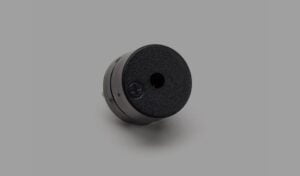Buzzer, horn antenna with a similar function, namely, the energy conversion from the action, the speakers, the key device, which is the electrical energy to sound energy is fundamental to sound chamber Danshi subsidiary device determines its maximum output power and frequency response, then We discuss the sound system down is to get the most energy.
What is Buzzer?

A buzzer is a mechanical, electromechanical, magnetic, electromagnetic, electro-acoustic or piezoelectric audio signaling device. A piezo electric buzzer can be driven by an oscillating electronic circuit or other audio signal source. A click, beep or ring can indicate that a button has been pressed.
Types of Buzzers
There are several different kinds of buzzers. At Future Electronics, we stock many of the most common types categorized by Type, Sound Level, Frequency, Rated Voltage, Dimension, and Packaging Type. The parametric filters on our website can help refine your search results depending on the required specifications.
The most common sizes for Sound Level are 80 dB, 85 dB, 90 dB and 95 dB. We also carry buzzers with Sound Level up to 105 dB. There are several types available including Electro-Acoustic, Electromagnetic, Electromechanic, Magnetic and Piezo, among others.
Buzzers from Future Electronics
Future Electronics has a complete selection of buzzers from several manufacturers that can be used as an electromagnetic buzzer, piezo buzzer, electro-acoustic transducer, piezoelectric transducers or magnetic buzzer for any electric circuit applications. Simply choose from the buzzer technical attributes below and your search results will quickly be narrowed in order to match your specific buzzer application needs.

If you have a preferred brand, we deal with CUI Inc, Intervox/ICC, Mallory and Murata, among others. You can easily refine your buzzer product search results by clicking your preferred buzzer brand below from our list of manufacturers.
Applications for Buzzers:
Typical uses of buzzers include:
- Alarm devices
- Timers
- Confirmation of user input (ex: mouse click or keystroke)
- Electronic metronomes
- Annunciator panels
- Game shows
- Sporting events
- Household appliances

Piezo buzzer is the handy sound generator used in electronic circuits to give an audio indication.It is widely used as an alarm generator in electronic devices. It is available in various types and sizes to suit the requirements. A Piezo buzzer has a Piezo disc and an oscillator inside. When the buzzer is powered, the oscillator generates a frequency around 2-4 kHz and the Piezo element vibrates accordingly to produce the sound. An ordinary Piezo buzzer works between 3 – 12 volts DC.

Working of the Piezo element
The piezo element is a circular-shaped metal plate with a thin coating of Piezo material. The piezo material used is Lead Zirconate Titanate. This material exhibits both Direct and Indirect piezoelectric properties. Indirect piezoelectric property is the vibration of the piezoelectric crystals in the presence of an electric field. The piezoelectric crystals also show direct piezoelectric properties in which mechanical stress like vibration or application of heat generates around 1-2 volts in the Piezo element. The white Piezo material coating is Positive while the rim of the element is Negative.
Oscillator circuit inside the buzzer consists of an Inductor, a transistor, capacitors, and resistors. When the oscillator circuit gets 3-12 volt DC, The transistor, Inductor combination oscillates which are fed to the Piezo crystals and the crystals and the plate vibrate according to the frequency. In order to give resonance, the rim of the element is glued to a plastic case so that the plate can vibrate freely.
Why Piezo buzzer generates piercing sound?
The oscillation in the Piezo buzzer is between 2 – 4 kHz. This sound is piercing because our hearing threshold is maximum in this frequency. Buzzer uses this frequency to get easy attention even in a highly noisy environment. Buzzers are used as alarms so this frequency is necessary.
How to handle Piezo element?
Piezo element is prone to weather changes and aging. The piezoelectric property may deteriorate due to aging and the buzzer may fail to work. The Piezomaterial is coated as a thin film so that during soldering, the wire along with the piezomaterial may detach. Once a portion of the Piezo material is detached, that element cannot be used. So always use very thin wire and apply solder only once. Overheating may damage the piezo material. If it is stored, use a plastic cover and keep it in a place free from moisture and heat.
Direct Piezoelectric Effect
Mechanical vibration can generate electricity in Piezo element. Connect a high bright transparent LED directly on the Piezoelement with the correct polarity. Gently tap in the central white part of Piezo element. LED will blink.



